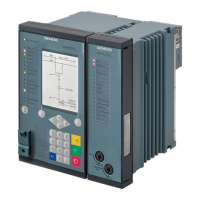[scrangzw-021210-01.tif, 1, en_US]
Figure 3-60 Routing of Metered Values to the Protection Interface in Device 1
This device also receives information (in the matrix under Receive). This must have been routed as a target for
other devices (see next figure). The binary outputs 1 and 2 in device 1 receive their information via the protec-
tion interface. This is priority 1 information, which has been routed in another device to position 3 and 4 of
the data bar. The secure state is defined in the Fallback value column. If the data connection fails, the single-
point indication is reset to coming or going or its value is retained (hold). For data of the various priorities,
you can also set a dropout time after which the reset (see Figure 3-60) to the fallback value occurs, in order to
retain the original state for a short time in the event of brief interruptions. These 3 dropout times apply for all
data of one transmission priority and are set as parameters.
[scspsemp-021210-01.tif, 1, en_US]
Figure 3-61 Routing of Single-Point Indications (Receive) to the Protection Interface in Device 1
The following figure shows the routing in the 2nd device. Binary inputs 1 and 2 are routed with priority 1 to
positions 3 and 4 there. In device 1, positions 1 and 2 are already occupied (see Figure 3-58). If you also route
the signals to positions 1 and 2, the signals of the devices are then connected to the corresponding position
with a logical OR operation. If measured and metered values are routed in the same data areas, this results in
implausible values for the receivers that read the data. As a user, you are therefore responsible for the correct
routing.
System Functions
3.5 Protection Communication
116 SIPROTEC 5, High-Voltage Bay Controller, Manual
C53000-G5040-C015-9, Edition 11.2017

